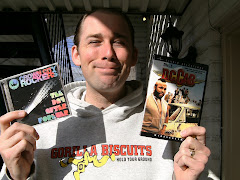There's no question mark after that title. And that's on purpose too. Forget everything I wrote about Precious, Mary and Max, and The Hurt Locker. Those "movies" don't come close to the miraculous ninety-nine minutes of celluloid projected in front of my eyes this very evening. The piece of artwork that I bore witness to changed my life. The very way that I look at cinema has been altered. No longer will I judge movies on the stories they tell, the quality of the acting performances, or even the cinematography. No more. I'm past all that now. From this day forward, movies will be judged solely by the amount of "thew thew thew" sound effects.
The importance of "thew thew thew" sound effects can not be understated. Without analyzing both the frequency and the properness of their use, one can't be sure if they movie they've just watched is actually any good. Take The Lady Eve, for example. It's been listed on Top 10 Lists, Top 5 Lists, and even the less popular yet undeniably pointless "Top 14 Lists" that were all the rage in the mid-1950s.
Some have argued that Eve is an important telling of one woman's struggle to win the heart of a snakeman. But how can these critics and scholars know this when NONE of their writings contain any form of structual evaluation of the "thew thew thews." Do you know how many "thew thew thews" can be found in The Lady Eve. Zero. Sorry to be a heartbreaker/soulshaker but the time for change is now.

For some (albeit, weak) examples of the "thew thew thew" sound effects I'm talking about, click these links:
Moving outside of the martial arts relm, TTTs have markedly improved films such as X-Men Origins: Wolverine when Gambit throws his exploding cards and Saving Private Ryan as the bullets whizz past the soldiers' heads. So, as you can see, TTTs have a vast array of uses and when applied in the proper ways, they have the power to make bad films mediocre.














No comments:
Post a Comment